The Middle East and North Africa (MENA) region is expected to become the world's seventh-largest cryptocurrency market in 2024, with an estimated on-chain value of $338.7 billion from July 2023 to June 2024, accounting for 7.5% of the global total transaction volume.
Authored by: Chainalysis
Translated by: Wuzhu, Golden Finance
The Middle East and North Africa (MENA) region is expected to become the world's seventh-largest cryptocurrency market in 2024, with an estimated on-chain value of $338.7 billion from July 2023 to June 2024, accounting for 7.5% of the global total transaction volume.
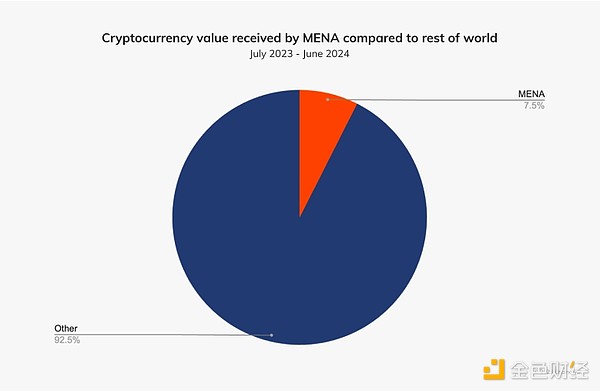
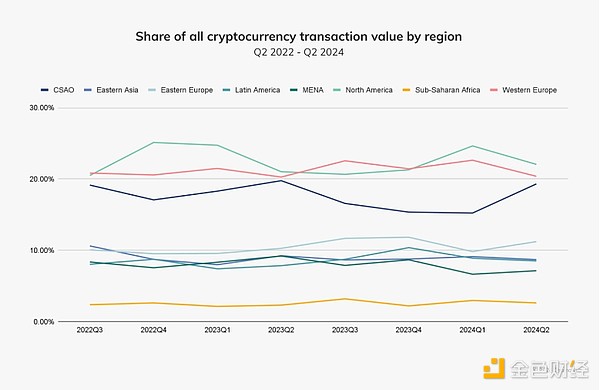
Although the market size is relatively small compared to other regions, the MENA region includes two countries ranked in the top 30 in the global cryptocurrency adoption index: Turkey (11th) and Morocco (27th), with values of $137 billion and $12.7 billion, respectively.
Most cryptocurrency activities in the MENA region are driven by institutional and professional-level activities, with 93% of the value transfer consisting of transactions of $10,000 or more.
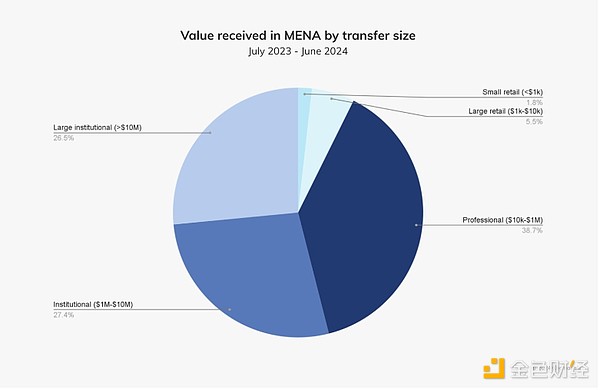
Overall, centralized exchanges (CEX) remain the main source of cryptocurrency inflows in the Middle East and North Africa, indicating that most users and institutions still prefer traditional cryptocurrency platforms. However, decentralized platforms and DeFi applications are steadily gaining attention, as shown in the heatmap below.
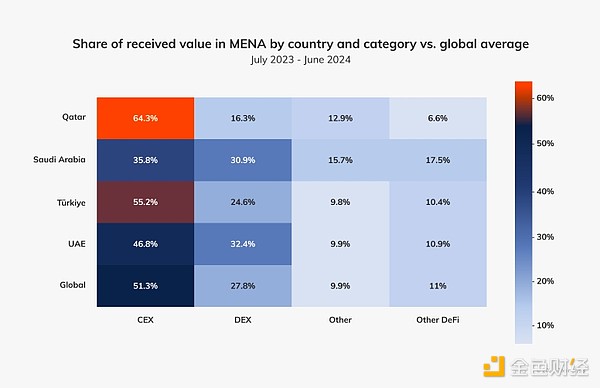
It is noteworthy that Saudi Arabia and the United Arab Emirates have shown a high interest in decentralized platforms. Most DeFi activities in the Middle East and North Africa occur on DEX, with Saudi Arabia's share in other DeFi activities slightly higher than other countries. Saudi Arabia, as a G20 economy with a population of over 30 million, benefits from a disproportionately young population—approximately 63% of citizens are under 30 years old. From the perspective of emerging technologies, this demographic structure is particularly meaningful, as the younger generation is often more willing to try new financial technologies. The adoption of DeFi in the UAE is also higher than the global average, possibly due to its progressive regulatory stance, which promotes clarity in specific categories of cryptocurrency participation. The proactive and collaborative regulatory approach taken by the UAE towards cryptocurrency and web3 companies has attracted a diverse range of users and solidified its position as a center for DeFi and broader cryptocurrency activities. In contrast, users in Turkey and Qatar still heavily rely on CEX, with lower DeFi participation compared to the global average.
It is noteworthy that Saudi Arabia and Qatar have not yet established comprehensive regulatory frameworks for Virtual Asset Service Providers (VASPs), and therefore do not have local CEX. However, Qatar's allowance for companies to apply for licenses to become token service providers is an encouraging new development that may reshape the future landscape.
In addition to fostering innovation, DeFi also provides an alternative financial system for individuals without bank accounts or with insufficient bank accounts, which is crucial for regions where less than 50% of adults (excluding high-income economies) had bank accounts as of 2021. While DeFi may not be widespread in some regions, its ability to provide financial services without intermediaries may drive future financial inclusion, opening up new opportunities for underserved individuals in regions and enabling them to access loans, savings, and investment tools that were previously unavailable.
The progress made in regulatory aspects by the major markets in the region in 2024 may further impact the distribution of DeFi and CEX platforms, thereby affecting financial inclusion and the broader adoption of decentralized financial systems.
Progress of Stablecoins and Altcoins in the Middle East and North Africa
In the Middle East and North Africa, the market share of stablecoins and altcoins is surpassing traditionally favored assets such as Bitcoin and Ethereum, especially in Turkey, Saudi Arabia, and the United Arab Emirates, where the trading volume share of stablecoins is higher.
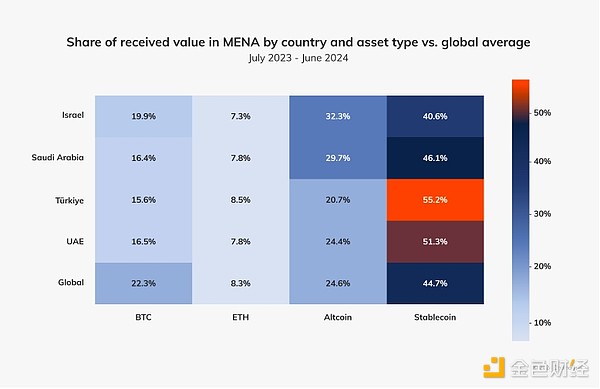
For example, in Turkey, where there is long-term economic instability and high inflation, retail reliance on stablecoins reflects their concerns about volatility and the demand for sustained value storage—we will detail this further below. In contrast, in the UAE, where the local currency (UAE Dirham) is pegged to the US dollar, the increasing popularity of stablecoins may reflect their popularity as a gateway to a broader range of cryptocurrency services and trading.
The usage of Ethereum (ETH) in the region is relatively stable but lower than the global average, with Turkey leading in participation. Meanwhile, Israel and Saudi Arabia have shown strong interest in altcoins, far exceeding the global average, which may reflect a higher risk appetite and interest in a wider range of assets beyond major cryptocurrencies. Last year, Israel successfully completed a government bond tokenization pilot, consistent with the industry's broader interest in tokenized assets—McKinsey predicts that the sector's scale could reach $40 trillion by 2030.
Clear regulations drive the balance of the UAE's cryptocurrency ecosystem
Driven by regulatory innovation, institutional interest, and expanding market activities, the UAE continues to experience rapid growth in the cryptocurrency field. From July 2023 to June 2024, the UAE received over $30 billion in cryptocurrency, propelling the country into the top 40 globally and making it the third-largest cryptocurrency economy in the Middle East and North Africa region.
Unlike most countries globally, cryptocurrency activities in the UAE are growing across all transaction scales, indicating a more balanced and comprehensive adoption landscape.
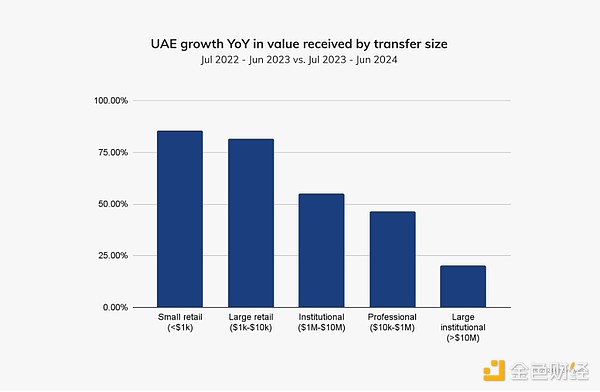
The country also boasts a diverse cryptocurrency ecosystem, including a wide range of activities beyond CEX, such as DeFi.
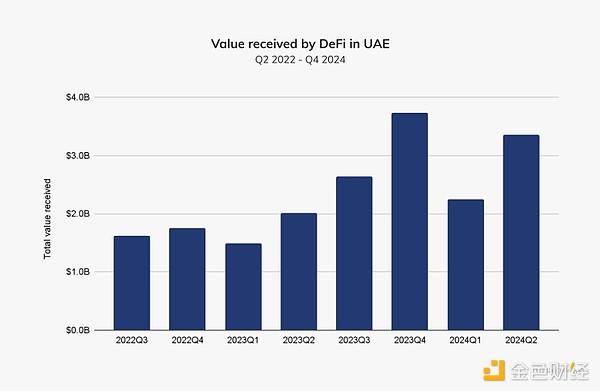
The total value of DeFi services, including DEX, increased by 74% from the previous year, with DEX alone experiencing an 87% revenue growth, rising from an estimated $6 billion to $11.3 billion.
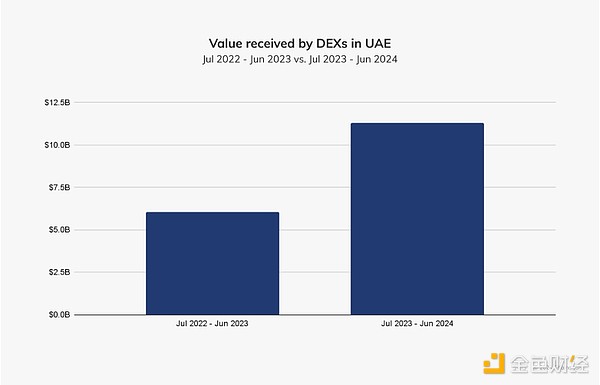
With numerous venture capital funds and blockchain companies opening branches in the UAE, cryptocurrency investments are rapidly expanding, including Chainalysis, which established its regional headquarters in Dubai in May this year. Tether, the largest cryptocurrency issuer by global transaction volume, recently announced plans to launch a stablecoin pegged to the dirham.
Arushi Goel, Policy Manager for Chainalysis in the Middle East and Africa, pointed out: "Traditional financial institutions such as banks are actively exploring their role in the cryptocurrency ecosystem, demonstrating the growth of the cryptocurrency-TradFi relationship. This participation is further supported by a robust and evolving regulatory framework."
In fact, as the global cryptocurrency market rebounds, governments around the world are working to develop regulatory frameworks that balance innovation with necessary safeguards. The United Arab Emirates (UAE) is at the forefront of these efforts, with each emirate's regulatory agencies developing tailored approaches. At the federal level, the Securities and Commodities Authority (SCA) regulates virtual asset services, while the Central Bank of the UAE (CBUAE) oversees payment token services. Additionally, the two financial free zones—the Dubai International Financial Centre (DIFC) and the Abu Dhabi Global Market (ADGM)—operate independent financial regulatory regimes, each with its unique virtual asset framework.
The Dubai Virtual Asset Regulatory Authority (VARA) also plays a crucial role in this regulatory expansion. Established in 2022, VARA is the world's first independent virtual asset regulatory authority, shaping the local market and attracting global attention.
Deepa Raja Carbon, Managing Director and Vice Chair of VARA, discussed the unique position of VARA as a regulatory authority two years after its establishment with Arushi Goel. "We have identified over a thousand entities engaged in crypto-related activities in Dubai, and we are in the process of legacy transition. Next year, we expect these entities to be licensed," she explained, emphasizing that VARA's approach is collaborative rather than blindly enforcing regulations. "Both the industry and regulatory agencies negotiate with this perspective—learning and developing together," she stressed the importance of balancing market protection and innovation.
VARA's influence extends far beyond Dubai, as its regulatory framework sets a precedent for other jurisdictions. The UAE is actively positioning itself as a global leader in emerging technologies, investing heavily in artificial intelligence (AI) and other advanced technology fields to solidify its reputation as a global innovation hub. This strategic focus further expands its influence on the cryptocurrency ecosystem, and VARA's collaborative and innovative approach is setting the tone for this ecosystem. "It's a fascinating moment to be involved as a regulatory authority," Carbon added. "You can witness ideas that change the game while providing a framework for them to be tested and brought to market faster than in traditional sandboxes."
In Turkey, stablecoins and high consumer participation are driving market maturity
Turkey is the largest cryptocurrency market in the Middle East and North Africa region and the seventh-largest globally, with a cryptocurrency value of $136.8 billion from July 2023 to June 2024.
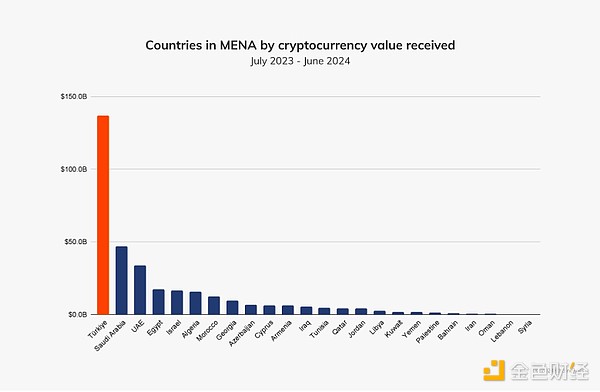
This strong activity is driven by an ecosystem defined by robust local CEX and the continued expansion of global platforms. As of the publication date, 76 CASPs have announced their intention to comply with regulatory requirements.
Additionally, as we mentioned in last year's report, Turkey's high inflation rate has hovered around 50% over the past year, driving much of the country's cryptocurrency adoption. In this high inflation environment, citizens turn to cryptocurrencies (especially stablecoins and altcoins) to hedge against currency devaluation and seek higher returns.
Cryptocurrency trading volume on the order book can provide valuable insights into the popularity of specific assets. Turkey's stablecoin trading volume as a percentage of GDP ranks first globally, by a wide margin.
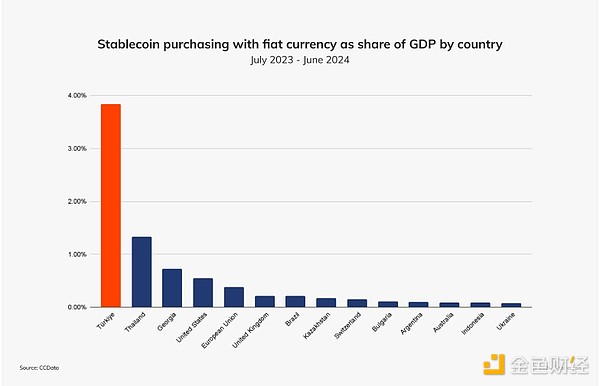
It is important to note that this metric does not mean that nearly 4% of Turkey's GDP is in stablecoins, but rather that the stablecoin trading volume on CEX is equivalent to 4% of the GDP in USD terms, indicating that cryptocurrency trading volume may one day surpass a country's GDP metric.
Stablecoins consistently account for the majority of cryptocurrency assets purchased with the Turkish lira, with the purchase volume in March this year approaching $6 billion. As shown in the chart below, stablecoin purchases with the Turkish lira are closely related to the inflation rate.*
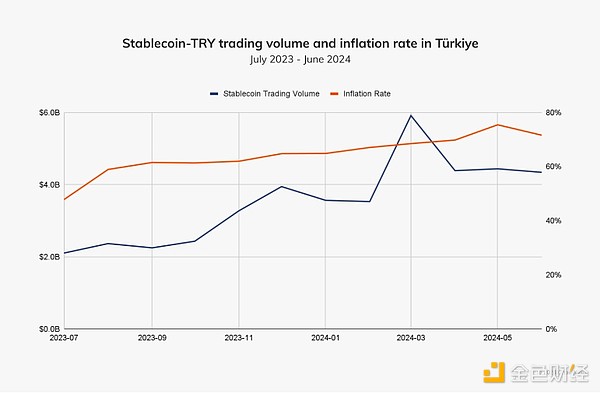
This reflects a broader trend we have observed over the years in unstable currency areas, where there is high demand for non-volatile assets (such as the US dollar and dollar-pegged stablecoins).
To further understand the cryptocurrency landscape in Turkey, we interviewed Francisco Maroto, Head of Blockchain at the Spanish multinational financial services company Bilbao Vizcaya Argentaria (BBVA), which has an office in Turkey. Maroto emphasized that cryptocurrency adoption in Turkey is primarily customer-driven, with an estimated 40% to 50% of the population engaging in cryptocurrency activities. This high adoption rate is related to consumers' need for financial protection in sustained inflation and their tendency towards higher-risk, higher-return tokens. "In addition to BTC and ETH, we see tokens for football teams and flashy tokens leading the trading volume," Maroto explained, describing how Turkish users are more likely to invest in speculative altcoins.
Garanti BBVA's cryptocurrency strategy in Turkey reflects the country's growing demand for cryptocurrencies. With regulations in place, Garanti BBVA has been offering cryptocurrency custody services since early 2024 and will soon launch trading services. Maroto pointed out, "We expect more banks to enter the market through new regulations," as Turkey recently amended the Capital Markets Law to include cryptocurrencies, aiming to enhance the market integrity and consumer protection of the cryptocurrency ecosystem. While the Turkish cryptocurrency market has historically been dominated by exchanges such as Binance and local CEX like Paribu, banks such as Akbank and Garanti BBVA are now entering the field, aiming to provide regulated services, including custody and trading.
With Garanti BBVA expanding its cryptocurrency products in Turkey, both retail and institutional clients are driving demand. Retail users often use cryptocurrencies for investment and inflation hedging, while institutional users (primarily investment funds) are increasingly participating in the market as it matures. Turkey has the highest share in professional-level cryptocurrency trading in the Middle East and North Africa region (43.2%), indicating a vibrant market for medium-sized transfers and large-scale retail activities.
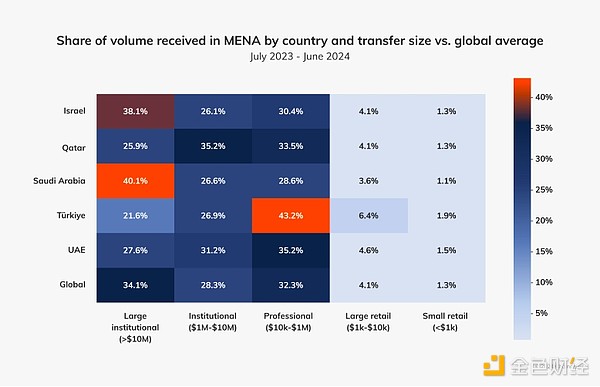
BBVA's focus on retail and institutional clients reflects the dynamic and rapidly evolving nature of the cryptocurrency market in Turkey.
With further developments in regulation, the Turkish cryptocurrency market is expected to further grow and has the potential to reshape the regional and global cryptocurrency ecosystem.
Saudi Arabia and Qatar are the fastest-growing cryptocurrency economies in the Middle East and North Africa
As in the previous year, Saudi Arabia remains the fastest-growing cryptocurrency economy in the Middle East and North Africa region, with a 154% year-on-year growth, focusing on blockchain innovation, central bank digital currencies (CBDCs), gaming, and fintech innovation.
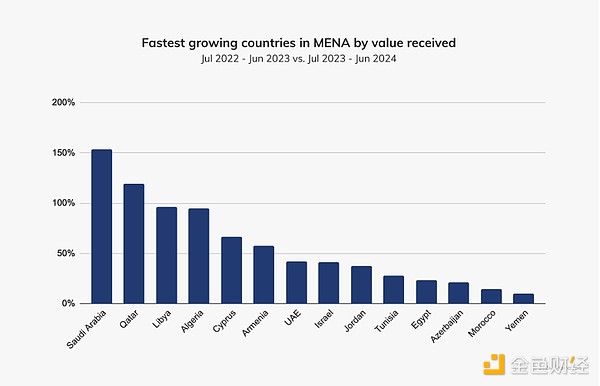
Several traditional financial (TradFi) giants such as Rothschild and Goldman Sachs have recently opened branches in Riyadh, joining Lazard, which has been operating in the country since 2011. With the accelerated adoption, TradFi institutions are increasingly favoring cryptocurrencies—Goldman Sachs plans to launch three tokenization projects globally by the end of this year. The young population of Saudi Arabia and the growing interest in cryptocurrencies provide opportunities for nurturing talent and innovation in the digital finance field.
Qatar closely follows, becoming the second fastest-growing market in the region with a year-on-year growth of 120%, and its regulatory stance is also evolving. The Qatar Financial Centre (QFC) launched a new digital asset regime in September, laying the legal and regulatory foundation for the development of digital assets, asset tokenization, and trusted technology infrastructure, paving the way for accelerated fintech innovation and contributing to the country's digital transformation journey.
As countries like Saudi Arabia and Qatar continue to experience rapid adoption, there is an opportunity for regulatory frameworks to develop in line with this dynamic landscape. Regulatory transparency can promote innovation, provide stability for businesses, and attract investors as consumer demand and market activity increase.
Mapping MENA's Global Influence
MENA is rapidly becoming a key player in the global crypto economy. The region's growth is driven by institutional and corporate activity, coupled with strong demand for DeFi and stablecoins, indicating that MENA's influence in the crypto space may expand. While CEXs still dominate, the rise of DeFi is reshaping the landscape, with countries like Saudi Arabia and the UAE embracing decentralized platforms. This highlights the potential of DeFi to drive financial inclusion across the entire MENA region, especially considering the large population with limited access to banking services.
Stablecoins and altcoins have also gained attention, especially in countries like Turkey, where the economic environment makes stable value storage desirable. Meanwhile, the UAE is positioning itself as a rapidly maturing and balanced crypto ecosystem, thriving under a regulatory framework that encourages innovation and broad participation from local and international markets.
Looking ahead, the regulatory progress made in 2024 will be crucial in shaping the future of crypto in MENA. As blockchain technology, tokenization, and cryptocurrencies become increasingly indispensable in the global financial landscape, these rapidly growing markets will benefit from providing further legal and regulatory certainty to sustain growth and attract international interest, solidifying the increasingly prominent position of the Middle East and North Africa in the global crypto ecosystem.
免责声明:本文章仅代表作者个人观点,不代表本平台的立场和观点。本文章仅供信息分享,不构成对任何人的任何投资建议。用户与作者之间的任何争议,与本平台无关。如网页中刊载的文章或图片涉及侵权,请提供相关的权利证明和身份证明发送邮件到support@aicoin.com,本平台相关工作人员将会进行核查。




